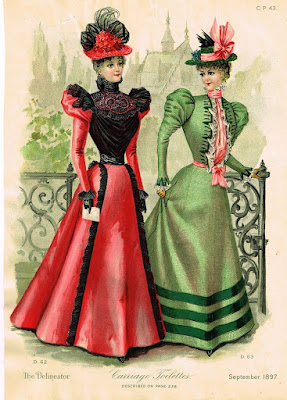The Return of the Bustle
Oddly enough in 1886 the bustle tries to make a triumphant return, while short lived, the
fabrics were lavishly trimmed in such diverse furs as sealskin, sable, blue fox and
Canadian beaver. The colors were browns, maroons, lichen green, petunia, sunflower
yellow, maize, and deep strong blues. In men’s garments serge, twill, flannel, tweeds,
checks and stripes enliven day attire. Colors are still subdued with black favored for
formal evening wear.
The Gay Nineties
The early 1890’s did not see a change in fabrics but the colors took a discordant turn.Yellow was in wide use especially for evening gowns with such vibrant new colors as
reds, heliotrope, pinks, lichen, and fawn. The men fashions merely added, as a variation
to their summer attire, white flannel trousers and dark coats.
As fashion was heading towards the next century, the colors became even more virulent in women’s fashions. The fabrics had at least become lighter in weight and more delicate in texture. Men finally see the rebirth of the brightly colored waistcoats last seen in the Regency era; otherwise the colors remained unchanged.
Turn of the Century
 Ah 1900 and a new century begins! The fabrics are soft and feminine, alpacas, mohairs, lawn, chiffon, muslin, and clinging velvets. Laces and other trims are used in abundance.
Ah 1900 and a new century begins! The fabrics are soft and feminine, alpacas, mohairs, lawn, chiffon, muslin, and clinging velvets. Laces and other trims are used in abundance.
The colors were harmonious or monochromatic schemes with touches of strong pure
evening and dark blues, greys, blacks, and silver greys frequently pinstriped.








No comments:
Post a Comment
Hello your post will be read before being posted in an effort to limit spam and create a family friendly blog.